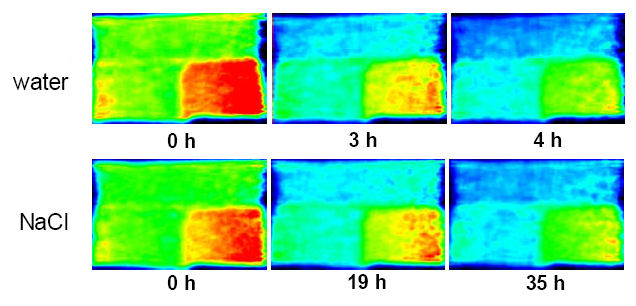
Figure 1: The experimental setup
An accurate choice of a re-pointing mortar is fundamental for successful restoration work. The use of an incompatibel mortar can affect the moisture transport inside the masonry and consequently lead to a different drying behaviour of the various materials: this can cause damage or speed up the decaying process already present in a masonry wall. For this research we have measured the moisture transport in a small masonry samples with dimensions of 50x30 mm and a thickness of 30 mm. In figure 1 the experimental set-up is given.

Figure 1: The experimental setup
In this experiment dry air was blown over the left side of the
sample. The experiment lasted 24 hours. Using a backward
projection method the moisture distribution was determined for
every hour. In figure 2 the measured 2D moisture
distribution is plotted for various times.

Figure 2: The 2D moisture distribution as measured during a drying experiment, at 0, 1 ,2 ,3 ,4,8, 16 and 24 h.
At t=0 the different materials show a moisture content related to
their porosity. As can be seen in this case the cement pointing
mortar is drying first. The bedding mortar is dry after 16 hours
aftes which the bricks ared dried.
In figure 3 another example is given of the drying of a sample. In
this case the drying was measured for a sample saturated with
water and a sample saturated with a 4 M NaCl solution. As can be
seen the drying is very similar in both cases only that the drying
is much slower in the case of NaCl.

B. Lubelli, R.P.J. van Hees and L. Pel, The role of the
pointing mortar in the damage due to salt crystallization,
Structural Studies, Repairs and Maintenance of Historical
Buildings, May 2001 Bologna, Italy , 536-547 (2001).
T. Diaz Goncalves, L.Pel, J. Delgado Rodrigues, Drying of
salt-contaminated masonry: MRI laboratory monitoring, Environ Geol 52, 293 302 (2007)